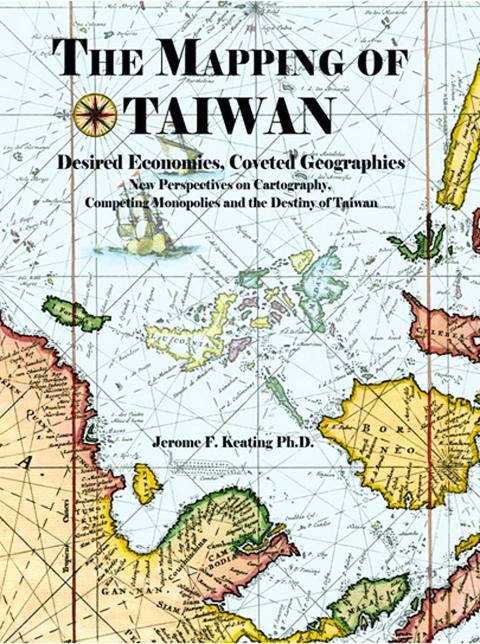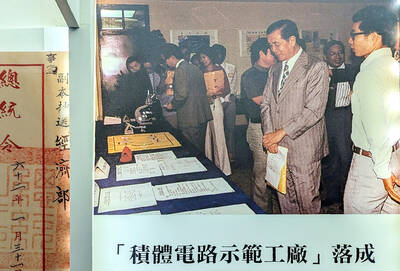When I first saw Jerome F. Keating’s The Mapping of Taiwan: Desire Economies, Coveted Geographies displayed at Bookman Books, a bookstore in Taipei’s Gongguan (公館) area located across the street from National Taiwan University, I was immediately attracted to its title and appealing layout. After I sat down and flipped through the large-sized work lavishly illustrated with maps dating back to the sixteenth century, it became immediately apparent that here was a volume that was going to fill a gaping hole on my bookshelf.
Keating is an old Taiwan hand. A prolific political commentator who has written a number of books about the country’s politics and history — all with a pro-Taiwan bent — he could have easily made The Mapping of Taiwan a screed against the myopic cultural and economic Sinification policies of the current administration, which views Taiwan as an indelible part of China. He doesn’t. Instead, we get a fairly balanced and vivid account of a country that is a conglomeration of the disparate peoples that have lived here.
His thesis is straightforward: As Taiwan became a “desired economy” in the great game of international trade, its “coveted geography” was mapped in ever increasing detail. Underlying this premise is the notion that Taiwan has for most of its history been mapped by those who have colonized it.

The story as told by Keating begins (and ends) with the nation’s important position as a hub for trade — even before Chinese and Europeans began cartographic depictions of the country. Drawing on recent research by scholars at Australian National University, he shows how Taiwan’s sea-faring indigenous tribes traded Fengtian jade, which can only be found here, as early as 7,000 years ago in a network that extended to the Philippines, Thailand, Malaysia and Vietnam.
“This is one of the many differences in the separate existence that Taiwan has had from life on the other side of the Straight. The history and early culture of Taiwan is a history that is connected more to the Pacific island world around it,” he writes. It’s a web of outward trade that would remain largely intact until foreign powers began populating the island and in the process marginalizing and decimating the autochthonous population.
The 15th century kicked off the great age of European exploration and discovery. Keating appropriately spends considerable space revisiting the era, providing detail to show how the growing European demand for silk and spices led Spain, Portugal and the Dutch, among others, to map Asia in ever increasing detail. Spain, for example, having established a base in Manila so as to bring silver from Mexico to trade for silk with China, sought a port in its trade lanes between the Philippines and Japan. As Keating puts it in his easygoing style, “Taiwan would fit that bill.”
As other countries became aware of the Taiwan’s strategic importance, a vague outline of it gradually emerged. A 1570 map by Abraham Ortelius shows “Fermosa” as a series of islets. A 1626 map by John Speed depicts the island as three separate sections. It’s only with a 1635 map by the Dutch mapmaking family of Willem Janszoon Blaeu, however, that the leaf-like contours of Taiwan emerge with any accuracy.
Keating’s several asides on religion, diplomacy and espionage make the chapters on European exploration especially interesting. Much like satellite technology today, he emphasizes that the possession of maps symbolized imperial power. They provided the location of buried treasure and secret passages, keys to navigation routes and dangers to avoid, the best ports to take shelter in during a storm and where to find currents to bring sailors home.
When powers clashed at sea, the victors would steal the maps of the defeated. On land, skullduggery was the order of the day. Spies sought out maps for their imperial masters at home. The Dutchman Jan Huygen van Linschoten, for example, stole several secret maps from the Portuguese, thus breaking their 100-year monopoly on the Spice Islands after he published them in a book.
But it was only in the 19th century, when Taiwan’s natural resources (tea, camphor, gold and coal) made it attractive in its own right that the nation’s internal features were mapped with any sophistication. Over the 50 years of Japanese rule, the first time a country took control of Taiwan in its entirety, the imperial power made maps of the country’s different ethnic groups — Aboriginal, Hakka and Hoklo — as well as mountains, rivers and roads.
Following Japan’s defeat in World War II, the Republic of China government, under the Chinese Nationalist Party (KMT), took control of the island. A map from the 1950s shows Taiwan as part of China — one of the few in the book that does so — and points to an ideological position that remains to this day.
But it’s the maps from the past decade that reveals the most momentous changes in Taiwan as an open, democratic and technologically advanced society. One satellite map shows population distribution throughout the island; another shows voting patterns for the 2008 Legislative Yuan elections. A third, and this is where the book comes full circle, is a map designating the ancestral lands of 10 of Taiwan’s indigenous tribes (today 14 are currently recognized by the government).
Interestingly, in a book that justifiably expends considerable space to show how foreign powers coveted and depicted Taiwan, and ends with a question mark about the nation’s future status, there are no contemporary maps of how China depicts it; nor are there any from the UN. A 2011 political map of the world (www.lib.utexas.edu/maps/world.html) from the library of the University of Texas at Austin color-codes Taiwan as part of China. It would have been illuminating to see how Taiwan is positioned within Asia’s current geo-political power struggles.
Yet perhaps this is beside the point because China’s claim to Taiwan is simply one that could be made by the many countries that have colonized it. For Keating, the crucial question is whether or not the people of Taiwan can incorporate “such diverse past narratives and write its own narrative.”
“Taiwan is at an important juncture,” he writes. “Taiwan’s future and its economy are for the first time in its history in the hands of its citizens; it can continue to create and control a clearly Taiwanese imagined community. It can map its own future.”
The Mapping of Taiwan is available at Bookman Books, 2F, 88, Xinsheng S Rd Sec 3, Taipei City (台北市新生南路三段88號2樓) and SMC Publishing Inc (南天書局), 14, Alley 14, Ln 283, Roosevelt Rd Sec 3, Taipei City (羅斯福路三段283巷14弄14號).

Oct. 27 to Nov. 2 Over a breakfast of soymilk and fried dough costing less than NT$400, seven officials and engineers agreed on a NT$400 million plan — unaware that it would mark the beginning of Taiwan’s semiconductor empire. It was a cold February morning in 1974. Gathered at the unassuming shop were Economics minister Sun Yun-hsuan (孫運璿), director-general of Transportation and Communications Kao Yu-shu (高玉樹), Industrial Technology Research Institute (ITRI) president Wang Chao-chen (王兆振), Telecommunications Laboratories director Kang Pao-huang (康寶煌), Executive Yuan secretary-general Fei Hua (費驊), director-general of Telecommunications Fang Hsien-chi (方賢齊) and Radio Corporation of America (RCA) Laboratories director Pan

President William Lai (賴清德) has championed Taiwan as an “AI Island” — an artificial intelligence (AI) hub powering the global tech economy. But without major shifts in talent, funding and strategic direction, this vision risks becoming a static fortress: indispensable, yet immobile and vulnerable. It’s time to reframe Taiwan’s ambition. Time to move from a resource-rich AI island to an AI Armada. Why change metaphors? Because choosing the right metaphor shapes both understanding and strategy. The “AI Island” frames our national ambition as a static fortress that, while valuable, is still vulnerable and reactive. Shifting our metaphor to an “AI Armada”

The older you get, and the more obsessed with your health, the more it feels as if life comes down to numbers: how many more years you can expect; your lean body mass; your percentage of visceral fat; how dense your bones are; how many kilos you can squat; how long you can deadhang; how often you still do it; your levels of LDL and HDL cholesterol; your resting heart rate; your overnight blood oxygen level; how quickly you can run; how many steps you do in a day; how many hours you sleep; how fast you are shrinking; how

“‘Medicine and civilization’ were two of the main themes that the Japanese colonial government repeatedly used to persuade Taiwanese to accept colonization,” wrote academic Liu Shi-yung (劉士永) in a chapter on public health under the Japanese. The new government led by Goto Shimpei viewed Taiwan and the Taiwanese as unsanitary, sources of infection and disease, in need of a civilized hand. Taiwan’s location in the tropics was emphasized, making it an exotic site distant from Japan, requiring the introduction of modern ideas of governance and disease control. The Japanese made great progress in battling disease. Malaria was reduced. Dengue was